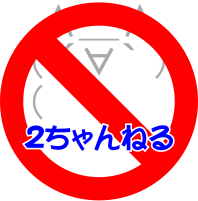
ASCII art is a graphic design technique that uses computers for presentation and consists of pictures pieced together from the 95 printable characters defined by the ASCII Standard from 1963 and ASCII compliant character sets with proprietary extended characters. The term is also loosely used to refer to text-based visual art in general. ASCII art can be created with any text editor, and is often used with free-form languages. Most examples of ASCII art require a fixed-width font such as Courier for presentation.

Mojibake is the garbled or gibberish text that is the result of text being decoded using an unintended character encoding. The result is a systematic replacement of symbols with completely unrelated ones, often from a different writing system.
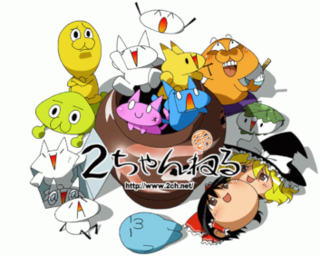
2channel, also known as 2ch, Channel 2, and sometimes retrospectively as 2ch.net, was an anonymous Japanese textboard founded in 1999 by Hiroyuki Nishimura. Described in 2007 as "Japan's most popular online community", the site had a level of influence comparable to that of traditional mass media such as television, radio, and magazines. At the time, the site drew an annual revenue of around ¥100 million, and was the largest of its kind in the world, with around ten million visitors and 2.5 million posts made per day.
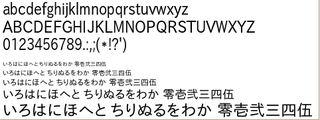
Mona Font is both a Japanese proportional pixel font for the X Window System, derived from the Shinonome raster font family, and a TrueType font. It aims to represent Shift JIS art graphics properly, almost all of which require the MS PGothic font. Mona is named after Mona, a character-based mascot of 2channel.
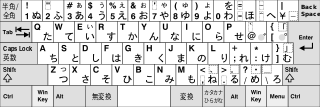
In relation to the Japanese language and computers many adaptation issues arise, some unique to Japanese and others common to languages which have a very large number of characters. The number of characters needed in order to write in English is quite small, and thus it is possible to use only one byte (28=256 possible values) to encode each English character. However, the number of characters in Japanese is many more than 256 and thus cannot be encoded using a single byte - Japanese is thus encoded using two or more bytes, in a so-called "double byte" or "multi-byte" encoding. Problems that arise relate to transliteration and romanization, character encoding, and input of Japanese text.
In computing, JIS encoding refers to several Japanese Industrial Standards for encoding the Japanese language. Strictly speaking, the term means either:
Shift JIS is a character encoding for the Japanese language, originally developed by the Japanese company ASCII Corporation in conjunction with Microsoft and standardized as JIS X 0208 Appendix 1.
Extended Unix Code (EUC) is a multibyte character encoding system used primarily for Japanese, Korean, and simplified Chinese (characters).
GB/T 2312-1980 is a key official character set of the People's Republic of China, used for Simplified Chinese characters. GB2312 is the registered internet name for EUC-CN, which is its usual encoded form. GB refers to the Guobiao standards (国家标准), whereas the T suffix denotes a non-mandatory standard.
Touhou Project, also known simply as Touhou, is a bullet hell shoot 'em up video game series created by one-man independent Japanese doujin soft developer Team Shanghai Alice. Since 1995, the team's member, Jun'ya "ZUN" Ōta, has independently developed programming, graphics, writing, and music for the series, self-publishing 19 mainline games and 13 spin-offs as of October 2023. ZUN has also produced related print works and music albums, and collaborated with developer Twilight Frontier on seven additional official Touhou spin-offs, most being fighting games.

JIS X 0201, a Japanese Industrial Standard developed in 1969, was the first Japanese electronic character set to become widely used. The character set was initially known as JIS C 6220 before the JIS category reform. Its two forms were a 7-bit encoding or an 8-bit encoding, although the 8-bit form was dominant until Unicode replaced it. The full name of this standard is 7-bit and 8-bit coded character sets for information interchange (7ビット及び8ビットの情報交換用符号化文字集合).

Netrun-mon is a single-episode Japanese original video animation which was created to celebrate the fifth anniversary of NetRunner magazine. NetRunner is a controversial publication since some articles promote hacking. Characters that are used to promote the magazine and are sold as merchandise have been taken directly from Hiroyuki's 2channel community. Hiroyuki himself is a character of Netrun-mon, one of the many references to Internet fandom in Japan that the anime is based upon.

Moe anthropomorphism is a form of anthropomorphism in anime, manga, and games where moe qualities are given to non-human beings, objects, concepts, or phenomena. In addition to moe features, moe anthropomorphs are also characterized by their accessories, which serve to emphasize their original forms before anthropomorphosis. The characters here, usually in a kind of cosplay, are drawn to represent an inanimate object or popular consumer product. Part of the humor of this personification comes from the personality ascribed to the character and the sheer arbitrariness of characterizing a variety of machines, objects, and even physical places as cute.
PostScript fonts are font files encoded in outline font specifications developed by Adobe Systems for professional digital typesetting. This system uses PostScript file format to encode font information.

Futaba Channel, or Futaba for short, also sometimes called 2chan, is a Japanese imageboard. Users of the website can upload pictures and discuss a wide variety of topics, from daily personal problems to sports, ramen, otaku and underground culture.
JIS X 0208 is a 2-byte character set specified as a Japanese Industrial Standard, containing 6879 graphic characters suitable for writing text, place names, personal names, and so forth in the Japanese language. The official title of the current standard is 7-bit and 8-bit double byte coded KANJI sets for information interchange. It was originally established as JIS C 6226 in 1978, and has been revised in 1983, 1990, and 1997. It is also called Code page 952 by IBM. The 1978 version is also called Code page 955 by IBM.
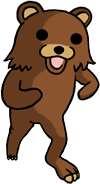
Pedobear is an Internet meme that became popular through the imageboard 4chan. As the name suggests, it is portrayed as a pedophilic cartoon bear. It is a concept used to mock child sex offenders or people who have any sexual interest in children or "jailbait". The bear image has been likened to bait used to lure children or as a mascot for pedophiles.
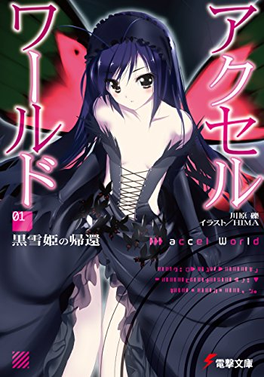
Accel World is a Japanese light novel series written by Reki Kawahara and illustrated by HiMA. The series began publication in ASCII Media Works' Dengeki Bunko imprint in February 2009 and is licensed in North America by Yen Press. Two manga series began serialization in Dengeki Bunko Magazine from May 2010, with another series beginning serialization in Dengeki Daioh in January 2013. An anime adaptation produced by Sunrise aired in Japan between April and September 2012. An English-language version began streaming on Viz Media's Neon Alley service in April 2013. Two video games were released for the PlayStation Portable and PlayStation 3 in September 2012 and January 2013, each containing an original video animation (OVA) episode. An anime film titled Accel World: Infinite Burst featuring an original story by Kawahara premiered in Japan in July 2016.
Microsoft Windows code page 932, also called Windows-31J amongst other names, is the Microsoft Windows code page for the Japanese language, which is an extended variant of the Shift JIS Japanese character encoding. It contains standard 7-bit ASCII codes, and Japanese characters are indicated by the high bit of the first byte being set to 1. Some code points in this page require a second byte, so characters use either 8 or 16 bits for encoding.





